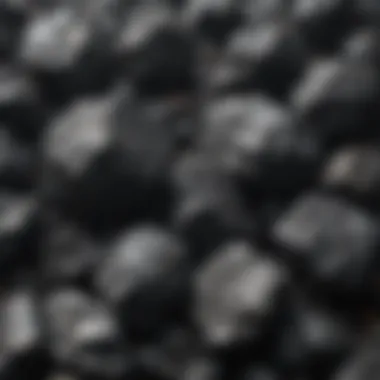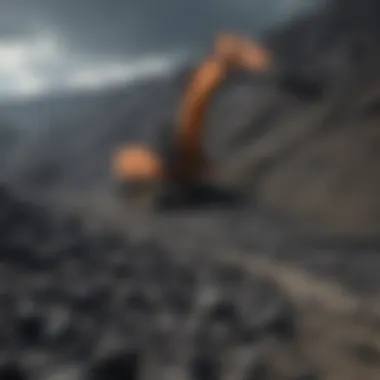Unraveling the Mysteries of Anthracite Coal: A Comprehensive Guide


Rock and Fossil Identification
Anthracite coal, despite not being a rock in the traditional sense, bears distinct characteristics that set it apart from other forms of coal. Its formation involves a lengthy process of coalification, resulting in a material with high carbon content and low moisture. Anthracite coal possesses a deep black color and a metallic luster, distinguishing it from softer coals like bituminous and lignite. When handling anthracite coal, one might notice its hardness and smooth texture, providing clues to its composition and quality. Tools such as magnifying loupes and hardness testers can aid in identifying anthracite coal specimens, guiding collectors in discerning this valued resource.
Geological Insights
Understanding the geological aspects of anthracite coal sheds light on its rarity and economic importance. Formed from the compression of organic matter over millions of years, anthracite coal occurs in regions with specific geological conditions, reflecting ancient environmental processes. The presence of anthracite coal suggests the former existence of swamps and peat deposits, highlighting the dynamic nature of Earth's geological history. Excavations in coal mines often unveil fossil imprints, giving researchers valuable insights into prehistoric ecosystems and climatic conditions. Through the study of these geological formations, scientists garner critical knowledge about both the past and present implications of anthracite coal.
Preservation and Display
Preserving anthracite coal specimens involves strategic methods to maintain their integrity and appeal. Due to its susceptibility to weathering and deterioration, collectors must store anthracite coal in dry, controlled environments to prevent degradation. Utilizing airtight containers or silica gel packs can safeguard specimens from moisture-induced damage, ensuring long-term preservation. Displaying anthracite coal creatively can enhance its visual impact, with options ranging from custom glass cases to LED-lit exhibition setups, inviting admiration and interest. By employing proper preservation techniques and imaginative display ideas, collectors can showcase the unique allure of anthracite coal while safeguarding its longevity as a cherished collection piece.
Introduction to Anthracite Coal
Anthracite coal, a gem in the realm of energy resources, stands as a beacon of efficiency and excellence. Known for its superior qualities, anthracite coal embodies a rich history of resilience and utility. In this article, we delve into the intricacies of anthracite coal, uncovering its profound impact on various industries and environments. Anthracite coal's significance lies in its unparalleled ability to fuel industrial processes with precision and cleanliness. By examining its formation, properties, and diverse applications, we aim to showcase the exceptional nature of this enigmatic resource.
Definition and Characteristics
Anthracite Coal Composition
Anthracite coal boasts a unique composition characterized by high carbon content and low volatile matter. Its dense structure and brilliant luster set it apart from other coal types. The composition of anthracite coal plays a vital role in its superior heating qualities, making it a preferred choice for various industrial and residential heating applications. Despite its exceptional purity, anthracite coal does pose challenges in combustion efficiency due to its low flame temperature.
Physical Properties
The physical properties of anthracite coal include a high carbon content, low sulfur content, and exceptional hardness. These attributes contribute to its high heat-producing capacity and low smoke emissions when burned. Anthracite coal's physical structure enables it to withstand high pressures and temperatures, making it ideal for metallurgical and energy production processes. However, its hardness can also present challenges in handling and transportation.
Chemical Composition
The chemical composition of anthracite coal primarily consists of carbon, hydrogen, oxygen, and nitrogen. The stable chemical structure of anthracite coal accounts for its clean-burning properties and low environmental impact. With minimal emissions of sulfur dioxide and nitrogen oxides, anthracite coal stands as a sustainable energy option. Despite its environmental advantages, the high carbon content of anthracite coal raises concerns about greenhouse gas emissions.
Formation Process
Geological Formation
The geological formation of anthracite coal traces back to ancient swamp ecosystems where plant matter underwent gradual carbonization. Over millions of years, heat and pressure transformed the organic material into dense, carbon-rich coal seams. The geological processes involved in anthracite formation contribute to its exceptional purity and energy content. While its geological origins showcase nature's transformative power, mining operations must navigate complex underground structures for extraction.
Transformation Stages
The transformation stages of anthracite coal involve several metamorphic processes that enhance its quality and energy density. Through compaction and heating, lignite and bituminous coal gradually transition into the high-grade anthracite. These stages of transformation are essential for developing the desirable characteristics of anthracite coal, such as low volatile matter and high carbon content. However, the prolonged transformation period requires patience and significant geological stability.
Mining Techniques
Mining techniques for anthracite coal extraction have evolved over centuries, incorporating advanced machinery and safety protocols. From traditional underground mining to modern surface mining methods, the industry has adapted to enhance efficiency and minimize environmental disruption. The choice of mining technique depends on factors such as seam depth, coal quality, and cost-effectiveness. While modern mining technologies have improved productivity, they also present challenges in land reclamation and ecological restoration.


Historical Significance
Early Uses
The early uses of anthracite coal date back to ancient civilizations where it served as a valuable fuel source for heating and metalworking. The exceptional heat generated by anthracite coal made it a prized commodity for households and blacksmiths. Its widespread availability and consistent quality contributed to the advancement of ancient industries and technologies. Despite its historical significance, early anthracite mining practices raised concerns about worker safety and environmental impact.
Industrial Revolution Impact
The industrial revolution ushered in a new era of growth and innovation fueled by anthracite coal's abundant energy reserves. As factories and railways expanded, anthracite coal played a pivotal role in powering steam engines and manufacturing processes. The clean-burning nature of anthracite coal revolutionized industrial production, setting new standards for efficiency and environmental responsibility. However, the rapid consumption of anthracite resources led to concerns about sustainability and depletion.
Anthracite in Modern Times
In modern times, anthracite coal continues to be a valuable resource for energy production and manufacturing. Its high energy content and low emissions make it an attractive choice for clean energy initiatives and metallurgical applications. Anthracite coal's versatility and reliability have secured its position as a premium fuel source in industries seeking sustainable solutions. Despite ongoing efforts to reduce reliance on fossil fuels, anthracite coal remains a cornerstone of energy production in various sectors.
Applications and Uses
In this captivating section on Applications and Uses of anthracite coal, we delve into its crucial role in various industries and everyday life. Anthracite coal stands as a multifaceted resource, presenting a myriad of uses that are essential to our modern society. Its significance stems from its diverse applications, which range from industrial to domestic settings, each playing a pivotal role in different sectors. Understanding the Applications and Uses of anthracite coal provides us with insights into how this resource fuels our industries and homes, making it a topic of great relevance and interest. This section will expound on specific elements, benefits, and considerations surrounding the Applications and Uses of anthracite coal, enriching our understanding of its widespread utility.
Industrial Applications
Energy Production
Energy Production from anthracite coal is a vital component of our energy landscape. This facet of anthracite coal utilization contributes significantly to meeting our global energy needs. Anthracite's key characteristic in energy production lies in its high carbon content and low impurities, making it a reliable and efficient energy source. The unique feature of anthracite coal's Energy Production is its energy density, providing more heat per unit compared to other coal types. While its efficiency is commendable, challenges like carbon emissions remain a concern in this sector.
Metallurgical Uses
The Metallurgical Uses of anthracite coal play an essential role in metal smelting and processing. Anthracite's purity and high carbon content are key characteristics that make it a popular choice in metallurgical applications. Its unique feature lies in its high heat generation and stable combustion properties, making it ideal for creating the high temperatures required in metallurgical processes. However, challenges related to ash content and sulfur emissions need careful consideration in its usage for metallurgical purposes.
Chemical Industry
Anthracite coal finds versatile applications in the Chemical Industry due to its unique properties. Its key characteristic of high carbon content and low volatile matter makes it a valuable raw material in chemical processes. The distinctive feature of anthracite coal in the chemical sector is its role as a reducing agent and carbon source in various chemical reactions. While it offers benefits like high purity and consistent quality, precautions are necessary to mitigate environmental impacts associated with its chemical utilization.
Domestic and Residential Uses
Heating
Examination of the Heating applications of anthracite coal reveals its importance in providing warmth for residential and commercial spaces in cold climates. The key characteristic of anthracite coal in heating is its high energy output and sustained burning properties, making it a preferred choice for heating purposes. Its unique feature lies in its clean-burning nature, emitting fewer emissions compared to other fossil fuels like wood or oil. Despite its advantages, proper ventilation and maintenance are crucial aspects to consider for safe and efficient heating with anthracite coal.
Cooking
Anthracite coal's role in Cooking applications adds a distinct flavor to culinary practices. Its key characteristic in cooking is its steady and even heat distribution, ensuring efficient cooking processes. The unique feature of anthracite coal in cooking is its ability to impart a smoky flavor to dishes, enhancing their taste profiles. While it offers benefits in heat control and flavor infusion, precautions must be taken to prevent carbon monoxide exposure and maintain air quality in kitchen settings.
Decorative Purposes


Exploring Decorative Purposes of anthracite coal unveils its aesthetic value in interior design and artistic expressions. The key characteristic of anthracite coal in decor lies in its lustrous texture and dark color, adding a sophisticated touch to decor elements. Its unique feature as a decorative material is its durability and timeless appeal, complementing various design styles. While it brings elegance to spaces, handling precautions are necessary due to its dusty nature and potential for staining surfaces.
Environmental Impact and Sustainability
The focus shifts now to the crucial theme of Environmental Impact and Sustainability in relation to anthracite coal. Understanding the impact of mining and using anthracite coal on the environment is paramount. The extraction process and burning of anthracite can lead to various environmental concerns such as air pollution, carbon emissions, and ecological disruption. Addressing these issues is imperative for ensuring a sustainable future. By exploring sustainable practices and embracing clean technologies, it is possible to mitigate the negative effects of coal usage.
Environmental Concerns
In considering the environmental concerns surrounding anthracite coal, three key aspects come to the forefront: Air Quality, Carbon Emissions, and Ecological Impact.
Air Quality
An essential aspect of the discussion revolves around the impact of anthracite coal on air quality. Emissions from burning coal contribute significantly to air pollution, affecting human health and the environment. The unique challenge of maintaining high air quality standards while utilizing coal underscores the need for technological advancements and stringent regulations in the industry. Finding a balance between energy production and preserving air quality remains a complex yet essential goal in the discussion of anthracite coal.
Carbon Emissions
Carbon emissions represent a critical environmental concern associated with anthracite coal usage. As a high-carbon fuel, anthracite coal combustion releases substantial amounts of carbon dioxide, a major contributor to climate change. Understanding the implications of these emissions is crucial for implementing strategies to reduce carbon footprints and promote cleaner energy alternatives. Despite its efficiency in energy production, the environmental impact of carbon emissions emphasizes the pressing need for sustainable practices in the coal industry.
Ecological Impact
The ecological impact of anthracite coal mining encompasses a broad spectrum of environmental implications. From habitat destruction to land degradation, coal mining activities can severely impact local ecosystems. Implementing eco-friendly mining practices and stringent reclamation efforts can help mitigate these effects and promote a more sustainable approach to coal extraction. Balancing industrial demands with ecological preservation is a key consideration in advancing towards a more sustainable coal industry.
Sustainable Practices
Within the realm of sustainable practices, several key strategies play a vital role in mitigating the environmental impact of anthracite coal.
Clean Technologies
Clean technologies offer a promising avenue for reducing the environmental footprint of anthracite coal operations. Implementing advanced filtration systems, emission controls, and energy-efficient processes can significantly decrease pollution levels and enhance overall sustainability. The integration of clean technologies highlights the industry's commitment to environmental stewardship and continuous improvement in reducing adverse environmental effects.
Recycling Initiatives
Recycling initiatives present another opportunity for enhancing the sustainability of anthracite coal usage. By repurposing coal by-products and waste materials, the industry can minimize environmental waste and optimize resource utilization. Incorporating recycling practices into coal production cycles not only reduces landfill burden but also contributes to a more circular and resource-efficient coal economy.
Eco-Friendly Mining
Eco-friendly mining practices represent a fundamental pillar in promoting sustainable coal production. Adopting technologies such as reforestation, water recycling, and responsible land use can mitigate the ecological footprint of coal mining operations. Emphasizing eco-friendly mining practices reflects a proactive approach towards environmental conservation and sets a benchmark for responsible resource extraction. By prioritizing sustainability in mining operations, the coal industry can foster a harmonious relationship with the environment and pave the way for a more sustainable future.
Anthracite coal has a significant presence in the global market, playing a pivotal role in various industries and economies worldwide. Exploring the global anthracite market offers valuable insights into the trends, challenges, and opportunities surrounding this unique resource. Understanding the dynamics of supply and demand, key players, and price fluctuations is essential in grasping the complexities of this market.
Market Trends
Demand and Supply


The demand and supply dynamics within the global anthracite market are intricate, with fluctuations influenced by factors such as industrial growth, energy requirements, and environmental policies. Demand for anthracite remains robust due to its high carbon content and energy efficiency, making it a preferred choice for steel production and energy generation. However, supply fluctuations, influenced by mining regulations and production costs, impact market stability. Despite these challenges, the reliability and quality of anthracite make it a popular option in various sectors.
Key Players
In the global anthracite market, key players are pivotal in driving innovation, sustainability practices, and market growth. Leading mining companies, processing plants, and distributors contribute significantly to shaping the market landscape. Their investments in technology, research, and supply chain management enhance the efficiency and competitiveness of the anthracite industry. However, market concentration among key players can lead to price variations and supply chain disruptions, posing challenges for market stability.
Price Fluctuations
Price fluctuations characterize the anthracite market, influenced by supply-demand imbalances, geopolitical factors, and economic trends. Understanding the nuances of price fluctuations is vital for market players to make informed decisions regarding investments, sourcing, and pricing strategies. Despite the volatility, price fluctuations also present opportunities for strategic positioning and market expansion. By closely monitoring price trends and factors driving fluctuations, stakeholders can adapt to market shifts and optimize their operations.
Regional Distribution
Top Producing Countries
The distribution of anthracite production across top countries such as Russia, China, and the United States significantly impacts global supply chains and market competitiveness. These countries possess extensive coal reserves, advanced mining technologies, and established export networks, positioning them as key players in the global anthracite market. Understanding the top producing countries' geopolitical influences, environmental regulations, and market share dynamics provides valuable insights for market analysis and strategic decision-making.
Export Markets
Anthracite export markets serve as crucial avenues for distributing coal products worldwide, linking producers to diverse consumer markets. Establishing robust export channels, trade agreements, and quality standards is essential for fostering sustainable growth and market expansion. Export markets also enable market players to diversify their customer base, mitigate risks, and respond to changing demand patterns effectively. By exploring export opportunities and market trends, stakeholders can optimize their export strategies and enhance market competitiveness.
Consumption Patterns
Analyzing the consumption patterns of anthracite consumers sheds light on the diverse applications, regional preferences, and market potential within different industries. Consumer behaviors, pricing trends, and regulatory frameworks influence anthracite consumption patterns, driving market demand and innovation. Understanding the nuances of consumption patterns enables market players to tailor their product offerings, marketing strategies, and sustainability initiatives to meet evolving consumer needs. By adapting to changing consumption patterns and market dynamics, stakeholders can position themselves for long-term success in the competitive anthracite market.
Future Prospects and Innovations
Technological Advancements
This section of the article dives into the critical aspect of Future Prospects and Innovations within the context of the enigmatic world of anthracite coal. As we look towards the future, understanding the advancements and innovations in this field becomes paramount. Technological advancements pave the way for the evolution of how anthracite coal is utilized and perceived in various industries.
Efficiency Improvements
Efficiency Improvements play a pivotal role in shaping the utilization of anthracite coal. By enhancing the overall efficiency of processes involving anthracite coal, industries can optimize their operations and reduce wastage. The key characteristic of Efficiency Improvements lies in its ability to streamline workflow and maximize output while minimizing resource consumption. It is a beneficial choice for this article as it sheds light on how optimizing efficiency can lead to sustainable practices and economic benefits. Efficiency Improvements bring a unique feature of precision and reliability, offering advantages in cost-effectiveness and productivity within the realm of anthracite coal applications.
Carbon Capture
Addressing Carbon Capture is crucial in the discourse of anthracite coal's environmental impact and sustainability. Highlighting how Carbon Capture technology can mitigate carbon emissions associated with anthracite coal utilization is essential in promoting greener practices. The key characteristic of Carbon Capture lies in its ability to capture and store carbon dioxide, thus reducing greenhouse gas emissions. This technology is a popular choice for this article as it aligns with the theme of environmental responsibility and sustainable practices. Carbon Capture's unique feature lies in its potential to curb climate change, presenting advantages in reducing carbon footprints and enhancing environmental stewardship within the context of anthracite coal industries.
Alternative Uses
Exploring Alternative Uses opens up new horizons for anthracite coal beyond traditional applications. Diversifying the utilization of anthracite coal can lead to innovative breakthroughs in various sectors. The key characteristic of Alternative Uses lies in its versatility and adaptability to different industries, offering a fresh perspective on the potential of this resource. This aspect is beneficial for this article as it prompts readers to consider unconventional applications of anthracite coal and encourages creativity in resource optimization. The unique feature of Alternative Uses lies in its capacity to drive experimentation and exploration, presenting advantages in fostering a culture of innovation and adaptability within the anthracite coal landscape.
Research and Development
Research and Development encompass a vital aspect of propelling the future prospects and innovations in anthracite coal industries. By investing in exploration projects, innovative applications, and environmental solutions, the potential for growth and sustainability in the realm of anthracite coal can be realized. Exploring new territories and methodologies through exploration projects contributes to expanding the knowledge base and uncovering untapped resources. The key characteristic of Exploration Projects is their investigative nature, driving curiosity and discovery within the anthracite coal domain. This aspect is a beneficial choice for this article as it emphasizes the importance of continuous exploration for industry advancements and resource optimization. Exploration Projects bring a unique feature of uncovering hidden potentials and strategic opportunities, offering advantages in expanding the scope of anthracite coal utilization and fostering strategic partnerships. Innovative Applications push the boundaries of traditional uses and invite new perspectives on anthracite coal's role in modern industries. By incorporating cutting-edge technologies and novel approaches, innovative applications redefine the boundaries of what is achievable with anthracite coal. The key characteristic of Innovative Applications is their forward-thinking nature, inspiring creativity and experimentation within the anthracite coal landscape. This aspect is advantageous for this article as it encourages readers to envision possibilities beyond conventional norms and unlocks the potential for groundbreaking innovations. Innovative Applications bring a unique feature of sparking ingenuity and adaptability, presenting advantages in fostering a culture of innovation and sustainability within anthracite coal sectors.
Environmental Solutions
Considering Environmental Solutions is essential for mitigating the ecological impact of anthracite coal industries. By implementing eco-friendly practices and technologies, the sector can minimize its environmental footprint and contribute to sustainable development. The key characteristic of Environmental Solutions is their focus on reducing negative environmental consequences while enhancing operational efficiency. This focus on sustainability makes Environmental Solutions a popular choice for this article as it aligns with the theme of ecological responsibility and long-term viability. Environmental Solutions bring a unique feature of promoting harmony between industry operations and environmental preservation, presenting advantages in creating a balance between economic prosperity and ecological stewardship within anthracite coal enterprises.







